Own Varieties
The newest Bulgarian Cveta alfalfa variety, approved by an order of the Minister of Agriculture, Food and Forestry in March 2021 is a property of IASS “Obraztsov Chiflik” Ruse.
Chief Assist.Prof. Diana Hristova Marinova, PhD
Assist.Prof. Iliana Ivanova Ivanova, PhD
Institute of Agriculture and Seed Science “Obraztsov Chiflik” – Ruse.
Cveta is the newest Bulgarian alfalfa variety, approved by an order of the Minister of Agriculture, Food and Forestry in March 2021. The variety was created and it is a property of IASS “Obraztsov Chiflik” Ruse. It is synthetic variety, created by polycross method of 9 parental clones. Cveta variety belongs to the traditional threefoliolate varieties. The breeding process began in 2005.
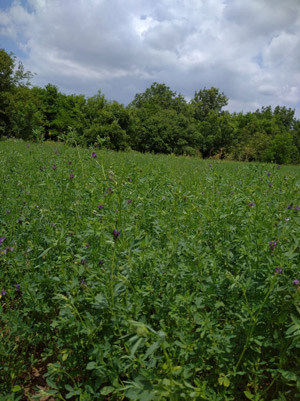

The plants natural height of Cveta variety in the spring is medium to high. The plants are upright and with strongly branched and well leafness stems. The leaves color is green. The inflorescence is blue-violet to dark blue-violet. In terms of dry matter content in green biomass, the variety exceeds the Prista 3 variety by 1.3 – 1.5 percentage units and by 8.5% in dry matter yield. The 1000 seeds weight is from 1.9 g to 2.3 g. Cveta variety is resistant to root and stem rot caused by Phytophtora sp.
The variety was created under the specific soil and climatic conditions of the Experimental Field of the Institute, which are characterized by extremely low temperatures in winter and very high temperatures in summer, combined with low soil and air humidity. This determines its wide ecological plasticity, high plant vitality and rapid growth of grass stands in spring.
The variety has a long longevity, which allows to be grown for 4-5 or more years, keeping good stand density. In years with normal rainfall, it forms 4-5 regrowths. Cveta belong to fall dormancy class 5 – average autumn latency. The variety has no specific requirements to environmental conditions and it can be grown without irrigation according to the traditional alfalfa cultivation technology.
PRISTA 5 ALFALFA VARIETY
The variety was recognized in 2013.
Plants are 70-79 cm high, well-branched and upright. The color of the leaves is green, the length of the middle leaflet is 2,6 cm, and the width – 1,0 cm. The inflorescence is light to dark purple.
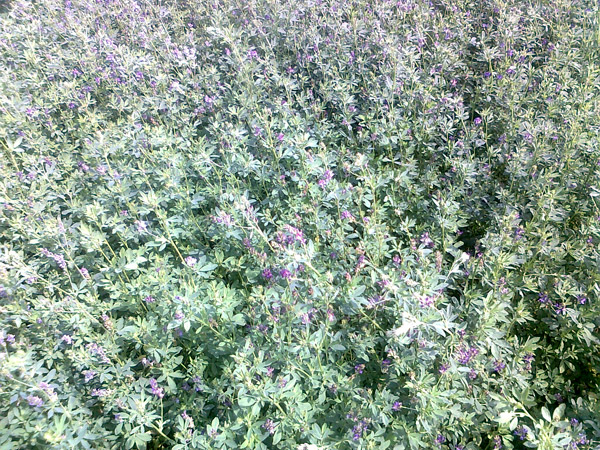
The results of the competitive examination has shown that Prista 5 variety exceeded by 7% the standards Prista 2 and Pleven 6 concerning dry matter yield. In years with normal precipitation, it makes 4-5 cuts.
Prista 5 variety is moderately resistant to powdery mildew – Erysiphe communis f. medicaginis and very resistant to root and stem rot – Phytophtora sp., and black leaf spots – Pseudopeziza medicaginis.
ROLI ALFALFA VARIETY
The variety was recognized in 2010.

“Roli” is a synthetic variety and refers to the group of the conventional trifoliolate alfalfa varieties.
High plants are 78 cm high, well branched and erected. The leave color is green, the length of the middle leaflet is 2,8 cm, and the width – 1,0 cm. The raceme is light to dark purple. The results of the competitive testing showed that “Roli” exceeded the standard “Prista 2” by 9,8% concerning dry matter yield and by 11,3% – seed yield. The number of cuttings was 4-5 during the years with normal precipitation. The variety exceeded the standard by 0,65 percentage units, concerning the content of crude protein.
PRISTA 3 ALFALFA VARIETY
The variety was recognized in 1994.
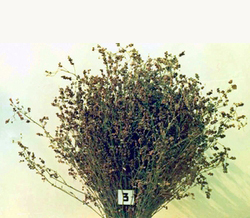
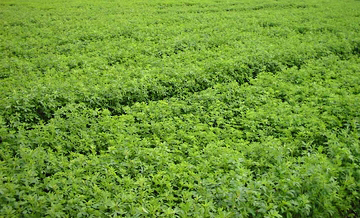
The stem is nearly erected, with height of 70 – 90 cm, with 6-9 internodes. The raceme is semi-compact, slightly elongated with dark blue to light purple petals. The variety is root rot resistant. It manifests very fast regrowth after cutting, and in favorable years 5-6 cuttings are obtained.
It exceeds Nadezhda 2 by 18,70% regarding dry matter yield, and by 15,4% in seeds yield.
PRISTA 4 ALFALFA VARIETY
The variety was recognized in 1994.
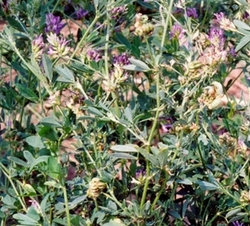
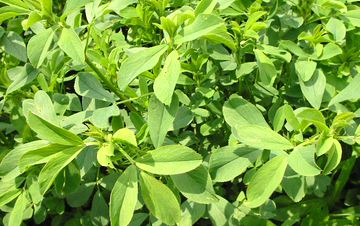
The plants are with erected habit, strongly leavness, with height of 75-95 cm, with 6-8 internodes. The raceme is loose, elongated, the petals with purple nuance.
It has fast spring and following cutting regrowth. It is with higher resistance to root rot than Nadezhda 2.It exceeds the standard in crude protein content and contains less cellulose. The yield of dry matter and seeds is 13,7% and 19,2% respectively. It is higher than those of the standard Nadezhda 2.
MNOGOLISTNA 1 ALFALFA VARIETY
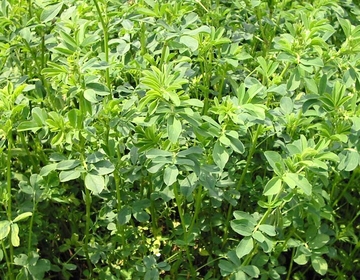
Mnogosistna 1 variety is a representative of the latest generation of multifoliolate alfalfa. More than 50 % of the leaves of the plants have from 5 to 7 leaflets per leaf. The content of crude protein is 1,5% higher than the trifoliolate varieties. The plants are strongly branched, dark green, with purple racemes prevailing.
The plants are resistant to leaf diseases and root rot. For the period of four years in total 6-8 t dry vegetative mass or 80-100 kg /da seeds without irrigation can be produced.


